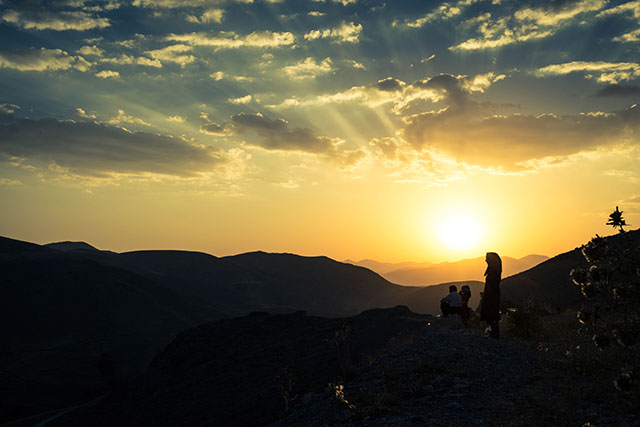
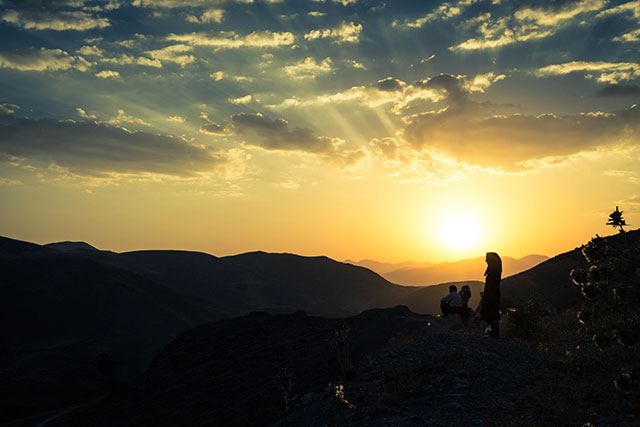 Bahar was an active member of the Komala, a Kurdish political group that pushed for agrarian reform, workers’ and women’s rights and the importance of diminishing the clout of tribal chieftains. In the aftermath of the uprising, she was arrested by the Revolutionary Guards for one year due to her political involvement. She has lost track of how many of her friends and acquaintances were executed. (Photo: Airin Bahmani)
Bahar was an active member of the Komala, a Kurdish political group that pushed for agrarian reform, workers’ and women’s rights and the importance of diminishing the clout of tribal chieftains. In the aftermath of the uprising, she was arrested by the Revolutionary Guards for one year due to her political involvement. She has lost track of how many of her friends and acquaintances were executed. (Photo: Airin Bahmani)
A view of the city of Sanandaj, the center of Kurdish life in Iran, marks the end of a hectic, eight-hour-long bus trip. The shuttle zigzags higher up, affording a rugged view of one of Iran’s northwestern mountain ranges and a stunning valley where Sanandaj is located.
At the city border, there is a checkpoint operated by the Revolutionary Guards. This is the first contact with state officials during the more than 500-kilometer journey from the Iranian capital of Tehran to the unofficial Kurdish capital. Iranian authorities inspect and keep record of all vehicles to and from Sanandaj. After armed officials of the Revolutionary Guards have searched our shuttle, we are permitted to continue to the city.
High walls rise in Sanandaj, extend for many kilometers and enclose vast areas, forming a number of closed zones within the city. “State officials, including personnel of the enormous security apparatus, have their own shops, schools, hospitals, swimming pools and gyms. They have small cities inside Sanandaj,” according to Bahar, an Iranian Kurdish woman in her 50s who has been deeply involved in Kurdish left-wing politics before, during and after the Iranian revolution. “Government employees live a well-off, sheltered life behind their walls and fences.”
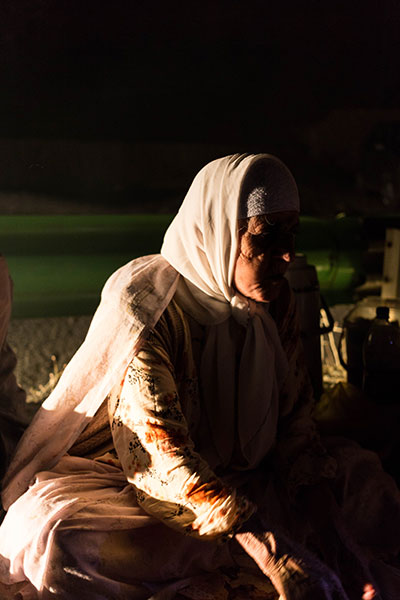 Roja’s son was executed by the state as part of the suppression of the uprising. (Photo: Airin Bahmani)“Anyone Can Be a Basiji”
Roja’s son was executed by the state as part of the suppression of the uprising. (Photo: Airin Bahmani)“Anyone Can Be a Basiji”
In Iran, the Revolutionary Guards, institutionally separated from the military, preserve the country’s politico-religious system of government. Following the Iranian Constitution, the Revolutionary Guards enforce the Shiite norms of the Islamic Republic. Basij, the paramilitary subdivision of the Revolutionary Guards, serves as a national intelligence network and imposes adherence to the state’s moral code.
The Iranian government recruits citizens to Basij from nearly all spheres of Iranian society. According to a conservative estimate, the number of Iranians who belong to the Basij system is in the millions. During peacetime, Basij’s duties include gathering intelligence on the political views of private citizens and communities and providing that information to the relevant state organs.
In its crackdown on the uprising, the Iranian government routinely resorted to lethal torture.
Among Iranian left-leaning dissidents and organizers, Basij is known for apprehending and subduing critical political activists. Bahar describes Basij as the eyes and ears of the government. “The efficacy of the institution is based on its gigantic size as it aggressively operates and recruits in comprehensive schools, associations and institutions – both government and privately owned – and at university level.
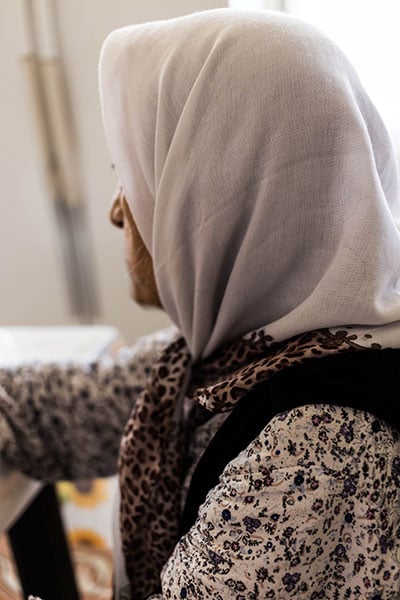 Daughters of Mariam were involved in Kurdish leftist politics before, during and after the ousting of the Shah. Two of the daughters were arrested and tortured. One was executed. (Photo: Airin Bahmani)“Anyone can be a Basiji. It is not a rare occurrence that a Basiji hides his or her state affiliations from family and relatives,” Bahar said.
Daughters of Mariam were involved in Kurdish leftist politics before, during and after the ousting of the Shah. Two of the daughters were arrested and tortured. One was executed. (Photo: Airin Bahmani)“Anyone can be a Basiji. It is not a rare occurrence that a Basiji hides his or her state affiliations from family and relatives,” Bahar said.
The perks and benefits that Basij collaboration entails are considerable and enticing to many citizens who might otherwise not harbor deep-seated sympathies or loyalties to the Shiite leadership. The perks include monetary bonuses, housing benefits and food stamps. Senior high school students joining Basij may be rewarded with scholarships to prestigious universities. It is likely that US-driven sanctions against Iran used to make these carrots ever more tempting. In a survey conducted in Tehran, 55.4 percent of Basij members were working class and 43.4 percent were lower middle class. Furthermore, official Iranian sources confirm that 62 percent of Iranians regard the multiple benefits offered by the state to Basij members to be the primary motive behind citizens’ interest to join the organization.
Quelling the Progressive Iranian Kurdish Uprising
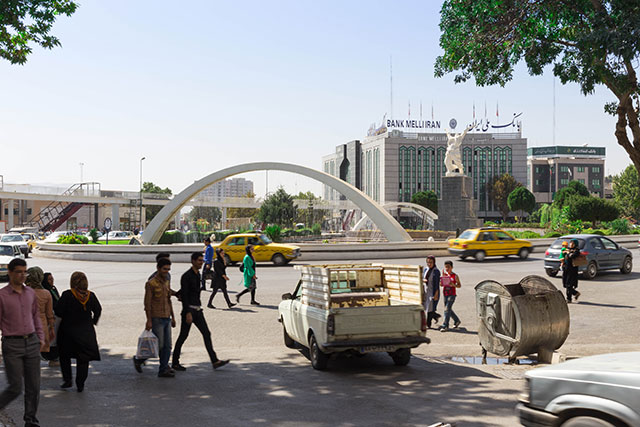 Sanandaj is the main stage of the young Shiite regime’s massive counterinsurgency against progressive Kurdish aspirations. (Photo: Airin Bahmani)
Sanandaj is the main stage of the young Shiite regime’s massive counterinsurgency against progressive Kurdish aspirations. (Photo: Airin Bahmani)
The atmosphere of suspiciousness and cautiousness instigated by Basij has a decades-long history, not least in the Kurdish areas of the country. For Ayatollah Khomeini’s Islamist cadre, which had just spearheaded a revolution, arguably the gravest and most immediate domestic challenge emerged from northwestern Iran in the form of a progressive, democratic and pluralistic Kurdish grassroots uprising.
During and after the Iranian revolution, the most powerful Kurdish political groupings were the Democratic Party of Iranian Kurdistan (KDPI) and the Komala. The KDPI advocated for a center-left platform and sought to secure Kurdish autonomy from Khomeini. Already in April 1979, the KDPI presented the government an elaborate deal in which Tehran would take the lead in matters of defense, foreign relations and long-term economic planning. In return, the central government would allow the establishment of an autonomous Kurdistan with its own parliament, which would exercise far-reaching legislative powers. In the KDPI’s proposal, Kurdish was to be recognized as an official language along with Persian.
“We longed for a social and political change and were ready to risk everything to attain it.”
Partly in agreement with the KDPI’s autonomy model, the Komala platform revolved around an emphasis on agrarian reform, workers’ and women’s rights and the importance of diminishing the clout of tribal chieftains. Initially a Marxist and feminist underground established in the late 1960s, the Komala gained immense popularity among Iranian Kurds soon after the revolution. The Komala enjoyed vast support among the country’s Kurdish population and had its most prominent strongholds in Sanandaj, Marivan and Baneh – all significant Kurdish cities in close proximity to one another.
“Fostering democratic process with a strong emphasis on a feminist and pluralistic platform was among the primary aims of our insurrection,” Bahar said.
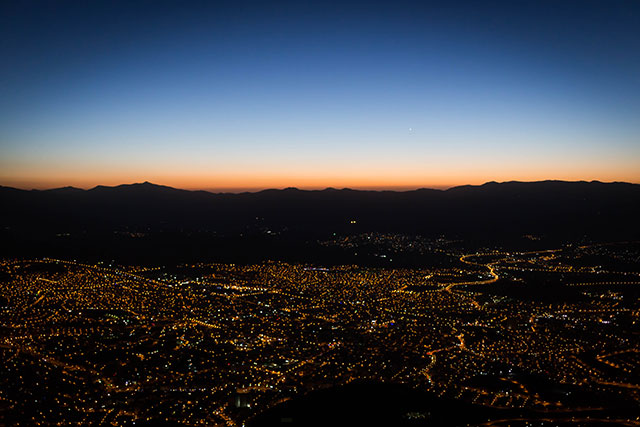 Sanandaj is the main stage of the young Shiite regime’s massive counterinsurgency against progressive Kurdish aspirations. (Photo: Airin Bahmani)
Sanandaj is the main stage of the young Shiite regime’s massive counterinsurgency against progressive Kurdish aspirations. (Photo: Airin Bahmani)
Although a solid majority of Iranian Kurds had supported the revolution, no consensus was reached between any Kurdish organizations and Khomeini on the future status of Iranian Kurdistan. Soon, fighting erupted between government forces and Kurdish fighters. The ensuing confrontation between the Shiite triumphalists and Kurdish political movements was to be a showcase not only for the Revolutionary Guards and its paramilitary Basij, but for the entire Islamist enterprise.
Of the numerous Iranian Kurdish cities, Sanandaj swiftly emerged not only as the center of left-oriented Kurdish popular uprising, but the main stage of the armed conflict. Exuding confidence in its ability to comprehensively reconfigure the post-Shah Iranian state at a rapid pace, the Shiite elite launched a full-scale counterinsurgency. Kurdish cities became targets of a heavy bombing campaign as the Islamists fired shells from state installations within those cities. Tehran also deployed its air force against the Kurdish rebellion.
Ultimately, incursion by the Revolutionary Guards and Basij paramilitaries into Iran’s Kurdish cities, particularly Sanandaj, proved an epoch-making event in the counterinsurgency. The Revolutionary Guards quickly smashed the armed wing of the revolt. State forces began searching houses one by one, hunting down the architects of the insurgency.
After resorting to a large-scale program of torture, interrogation and blackmail, the Iranian authorities managed to chart the structure and plans of the rebellion. Between 1979 and 1982, the Iranian government killed approximately 10,000 Kurds – a considerable portion in mass executions.
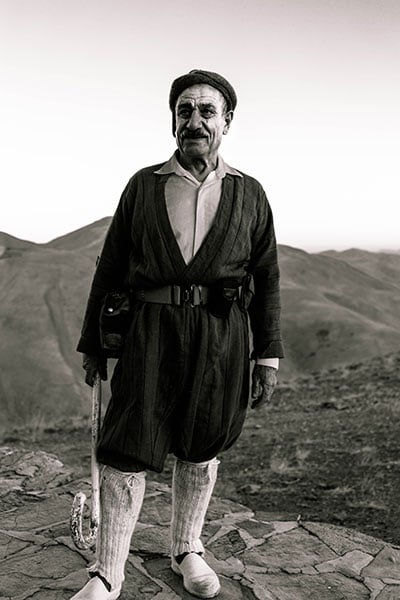 Kurdish men in Sanandaj. Iran is exceptionally diverse ethnically, religiously and linguistically. According to human rights groups, the Islamist leadership continues to discriminate against many of the country’s minorities. (Photo: Airin Bahmani)Lasting Emotional and Physical Trauma
Kurdish men in Sanandaj. Iran is exceptionally diverse ethnically, religiously and linguistically. According to human rights groups, the Islamist leadership continues to discriminate against many of the country’s minorities. (Photo: Airin Bahmani)Lasting Emotional and Physical Trauma
Every single eyewitness interviewee of ours, including Bahar, recollects how the state delivered death sentences in the style of an assembly line. A preponderance of the death sentences was issued by the judge Ayatollah Sadiq Khalkhali, who earned the nickname the “Hanging Judge.” Our interviewees stressed the personal role of Khalkhali in subduing the uprising.
When Khalkhali died in 2003, his legacy was praised in the Iranian Parliament. Speaker of the Parliament Mehdi Karoubi paid tribute, in particular, to Khalkhali’s performance in the early phases of the revolution.
“We were all waiting for our turn,” Bahar said. “Participants in the uprising were being arbitrarily executed. State forces inflicted the most cold-blooded torture techniques on us, making sure that those of us who they preferred alive did not die.”
Bahar was released after a year in custody. Most of her family members were either summarily executed or managed to flee the country.
“Later, we got back the body of our cousin Reza, a member of the Komala,” Bahar said. “His torso was full of burns, contusions and bruises. A large emblem of Iran, the crescent and a sword, was burned to his rib cage. Reza was far from the only member of my family who was tortured to death.”
Later, the Revolutionary Guards destroyed Reza’s grave, alongside the graves of all other known political activists and prisoners. It was inconceivable for the authorities to allow any indication of a political status of those buried in the main cemetery in Sanandaj. Furthermore, they did not tolerate the gravestones to be inscribed with the names of the deceased if they had any affiliations with the uprising.
After the early phases of the uprising, the authorities stopped delivering the bodies of Kurdish activists back to their families. “All we have left of Reza is his memory and a location he was buried in,” Bahar said.
It is not just through the experiences of her family members and friends that Bahar is familiar with the details of the state’s counterinsurgency campaign. In 1983, she was arrested by the Revolutionary Guards.
“We were taken to an interrogation room one by one. When it was my turn, they blindfolded me and brought me into the room. There were a number of interrogators and officers present. They forced me to lie down on my stomach and tied me to a metal bed. I was bombarded with questions on my political activities, my motives, my comrades and their whereabouts. My answers did not appeal to the interrogators. They began lashing the soles of my feet with power cables. This happened continuously, day after day, until I was unable to walk. If I wanted to move, I had to crawl. The interrogators brought me a wheelchair. Then the foot whipping continued.”
In its crackdown on the uprising, the Iranian government routinely resorted to lethal torture as well as torture that caused permanent damage. “The pain inflicted on many of us was so severe that it will stay with us for the rest of our lives. Presently, in 2015, I can still feel it every single day. Bastinado [foot whipping] led to neuralgia. According to a doctor, nerve pathways in my feet have been damaged and will never heal.”
Bahar shared in great detail how she and all of her comrades gave it their all, as she put it, “to finally emancipate [Iran] from the yoke of authoritarianism … [which the nation] had witnessed since the ousting of Mohammed Mossadegh in 1953.”
The organizers of the uprising will carry with them the defeat they suffered for the rest of their lives. “We longed for a social and political change and were ready to risk everything to attain it,” Bahar said. “Notwithstanding our best efforts, we did not succeed. What we were left with is lasting emotional and physical trauma.”
Roja, an 84-year-old woman of Kurdish descent whose nine children all participated in the uprising as members of the Komala, digs up a photo album of her son who was executed in Sanandaj in 1982. It is prohibited to engage in any commemoration of those killed in the suppression of the uprising, hence documents such as photos must be hidden. As routine practice, Revolutionary Guards deploy officers to put an end to all forms of organized commemoration.
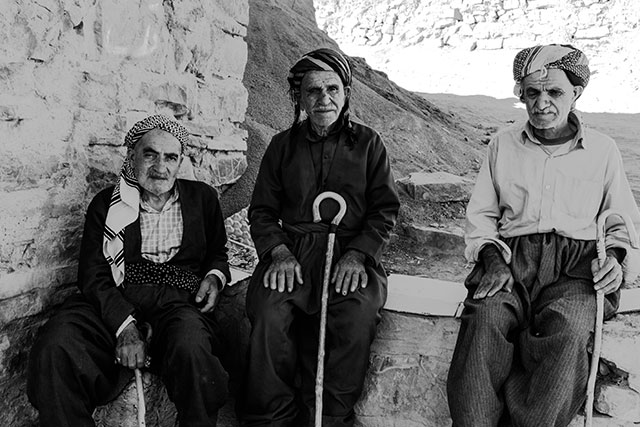 Kurdish men in Sanandaj. Iran is exceptionally diverse ethnically, religiously and linguistically. According to human rights groups, the Islamist leadership continues to discriminate against many of the country’s minorities. (Photo: Airin Bahmani)
Kurdish men in Sanandaj. Iran is exceptionally diverse ethnically, religiously and linguistically. According to human rights groups, the Islamist leadership continues to discriminate against many of the country’s minorities. (Photo: Airin Bahmani)
Looking at photos of her son, Roja commented on the political trajectory of Iran after the Shah. Roja, who has lived under the rule of Reza Shah, Mohammed Mossadegh, Shah Mohammad Reza Pahlavi and now the Islamists, observed that never in her lifetime “has there been such a long period marked by a lack of momentum in Kurdish popular-based progressive politics as after the quelling of the uprising in the early 1980s. The state reached its goal of completely annihilating Kurdish leftism.”
That every single one of our 24 interviewees can list countless people from their circle of acquaintances who were either executed or severely tortured suggests the scope and brutality of Tehran’s counterinsurgency.
A most salient conclusion to be drawn from our interviews with organizers of and participants in the uprising is that the Shiite republic ultimately succeeded in completing something in which even the Shah and his secret police, the Savak, had failed: obliterating the socialist and progressive political momentum among the Iranian Kurds.
Press freedom is under attack
As Trump cracks down on political speech, independent media is increasingly necessary.
Truthout produces reporting you won’t see in the mainstream: journalism from the frontlines of global conflict, interviews with grassroots movement leaders, high-quality legal analysis and more.
Our work is possible thanks to reader support. Help Truthout catalyze change and social justice — make a tax-deductible monthly or one-time donation today.